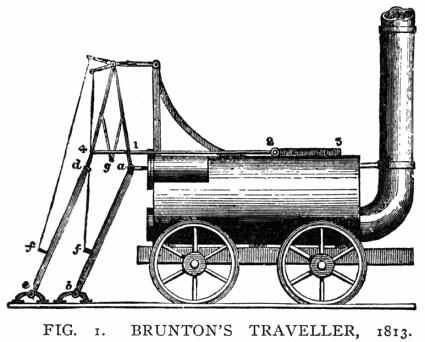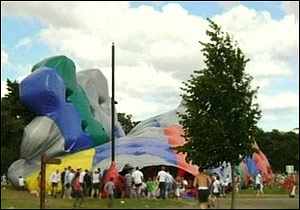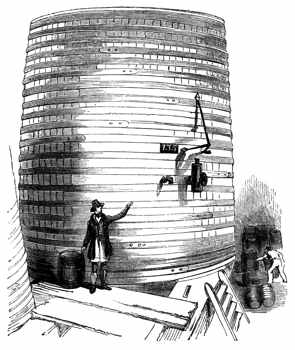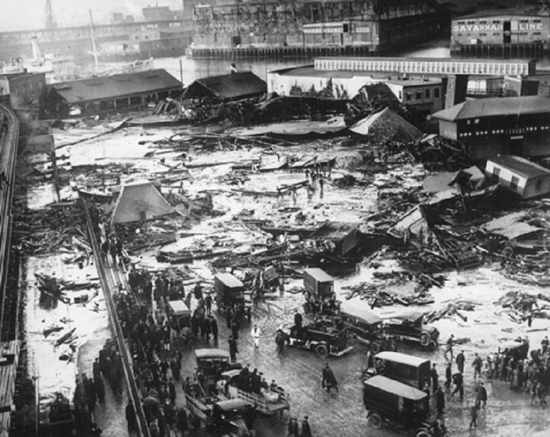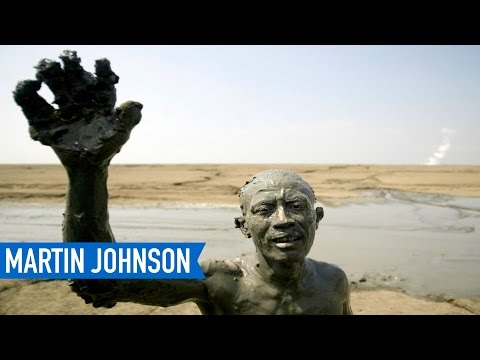On 31 July, 1815, in Philadelphia, County Durham, England, an early experimental railway locomotive, Brunton’s Mechanical Traveller, blew up. This engine, also known as the Steam Horse, ran on four wheels but was pushed by mechanical feet. This was both the first recorded boiler explosion and the first railway accident causing major loss of life, as 16 people were killed. The accident is not included in many texts because it was on an industrial waggonway or plateway, rather than a public railway. Most boiler explosions caused severe mechanical damage but often only the locomotive crew suffered physically; however, Brunton’s locomotive was surrounded, at the time, by a crowd of curious sightseers, who formed the majority of the victims.
In July, 2006, a bouncy castle, with 30 people inside it, broke free from its moorings and took off into the air in a freak gust of wind. It flew 50 feet into the air, turned over, and travelled 150 feet before landing on the ground. The castle seriously injured 13 people and killed two. An eye-witness described the event thus: “I heard the snapping of tent pegs and a lot of screaming, then the inflatable flew up into the air and bodies were dropping from it. It was just carnage. There were people everywhere lying on the ground. Some had been on the inflatable when it took off, others were hit on the ground.”
Lady Coventry, or Maria Gunning, was a celebrated beauty of her time. She devoted herself to applying pasty white makeup and red rouge every day. This was the style of the time. Her husband hated this practice and tried to stop her from doing it, but her vanity prevailed. She probably should have listened to him. Lady Coventry died at the age of 27 from over use of lead-based makeup.
Rumor has it that while Napoleon was suffering from a bad cough he accidentally ordered the execution of 1,200 prisoners. His officers had been awaiting orders from the emperor when he was seized by a coughing fit. The emperor exclaimed “Ma sacre toux,” meaning “My damn cough,” (or literally “My sacred cough,” but I think we know what he meant). His men took his words to be “Massacre-tous,” meaning “Massacre all.” This strange accident would top the list if it were proven. However, accounts of the incident vary greatly and many doubt whether this ever happened.
The Lake Peigneur accident was caused by drilling in a salt mine beneath the shallow (10 feet deep) lake. The drill accidentally pierced the third level of the mine causing the lake to drain into the hole. This resulted in the expanding of the hole as soil and salt were washed into the mine by the rushing water, filling the enormous caverns left by the removal of salt over the years. The resultant whirlpool sucked in the drilling platform, eleven barges, many trees and 65 acres (260,000 m2) of the surrounding terrain. So much water drained into the caverns that the flow of the Delcambre Canal that usually empties the lake into Vermilion Bay was reversed, making the canal a temporary inlet. This backflow created, for a few days, the tallest waterfall ever in the state of Louisiana, at 164 feet (50 m), as the lake refilled with salt water from the Delcambre Canal and Vermilion Bay. The water downflowing into the mine caverns displaced air which erupted as compressed air and then later as 400-foot (120 m) geysers up through the mineshafts.
The Goiânia accident was a radioactive contamination accident that occurred on 13 September, 1987, at Goiânia, Brazil. Considered one of the worst nuclear disasters in history, it took place after an old nuclear medicine source was scavenged from an abandoned hospital site in the city, which serves as capital of the central Brazilian state of Goiás. It was subsequently handled by many people, resulting in four deaths and the serious radioactive contamination of 249 other people. The dispersal of radiation was equivalent to a medium-size dirty bomb. About 130,000 people overwhelmed hospitals. Of those, 250 people, some with radioactive residue still on their skin, were found to be contaminated through the use of Geiger counters. Topsoil had to be removed from several sites, and several houses were demolished. All the objects from within those houses were removed and examined. Those that were found to be free of radioactivity were wrapped in plastic bags, while those that were contaminated were either decontaminated or disposed of as waste.
On October 16, 1814, a vat of beer at London’s Meux and Company Brewery cracked open. Beer gushed out, causing yet another vat to open. The result was 550,000 gallons (or 4.4 million pints) of beer pouring through the streets of London. The wave of beer destroyed two homes and crumbled the wall of the Tavistock Arms Pub, trapping teenaged employee Eleanor Cooper under the rubble. The brewery was located among the poor houses and tenements of the St Giles Rookery, where whole families lived in basement rooms that quickly filled with beer. Eight people drowned in the flood. The disaster was ruled to be an act of God.
On January 28, 1393, King Charles VI of France hosted a ball to celebrate the marriage of Queen Isabeau’s maid of honor. Charles had the brilliant idea to have himself and five of his friends disguise themselves as savages. The idea took a strange turn when the men decided to cover themselves with pitch and feathers. Remember, pitch is very flammable and the primary sources of light indoors at the time were torches. The men entered the ball disguised this way and chained together. A horrible accident occurred when a man approached them with a torch so that he could get a better look. The men went up in flames immediately. The king was saved by Jeanne de Boulogne, who threw her petticoats over him to put out the blaze. One other of the men was able to throw himself into a vat of water. The other victims of this strange accident were not so lucky. Two burned alive that night at the ball. The other two died within days from their injuries.
On January 15, 1919, a tank of molasses exploded in Boston’s North End. The explosion caused a huge shockwave that was sufficient to knock houses off their foundations. Shards of metal from the tank were found up to 200 ft. away. Right after the explosion this accident took a very strange turn. The tank was filled with 2.3 million gallons of molasses. When the tank exploded, the molasses formed a 25-30 ft. wave, that went through the streets of Boston at speeds of around 35 mph. People caught in the wave were either smashed against large objects, or they drowned in the molasses. This strange accident caused 21 deaths and 150 injuries. Rumor has it that, on a hot day in the North End, the air still smells sweet.
In May, 2006, while drilling for gas in East Java, Indonesia, company PT Lapindo Brantas caused a mud volcano to erupt. By September, 2006, the hot mudflow had inundated rice paddies and villages, resulting in the displacement of more than 11,000 people from eight villages. Twenty-five factories had to be abandoned, and fish and shrimp ponds were destroyed. Transportation and power transmission infrastructure has been damaged extensively in the area. The mud flow is still ongoing at a rate of 100,000 m3 per day, at time of writing. A study has found that the mud volcano is collapsing under its own weight, possibly beginning caldera formation. It is expected that the flow will continue for at least another 30 years. Watch this video on YouTube
Portions of this list were purchased by Listverse from Shelly Barclay for publication here. It is normally our policy not to publish lists that already exist on the Internet and today we have discovered that Miss Barclay is not only selling her content, she is publishing it herself as well – a factor that would have excluded us from using her work. Nevertheless, Listverse has paid for the content and it will remain here.
